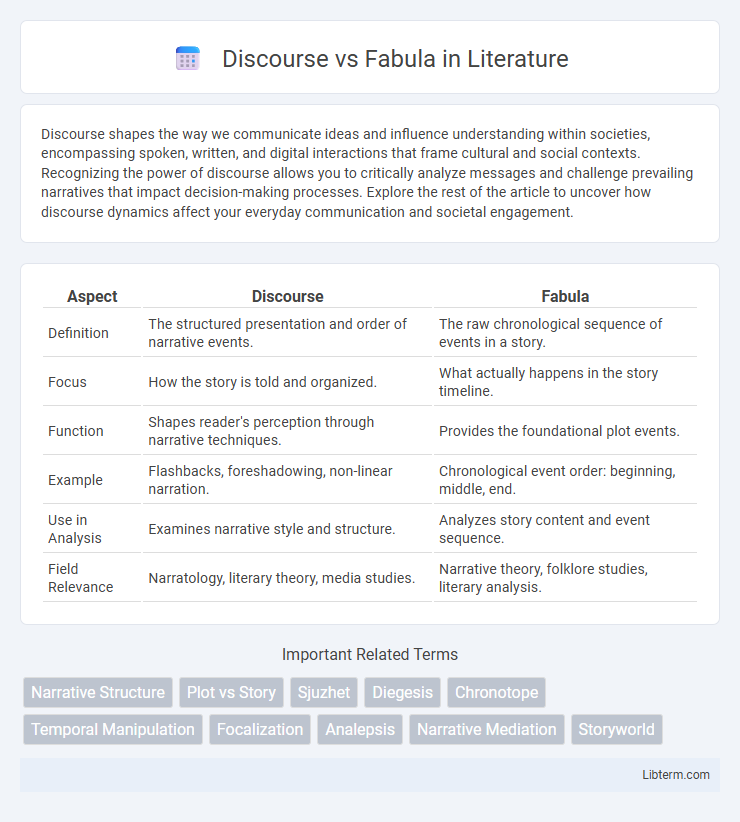Discourse shapes the way we communicate ideas and influence understanding within societies, encompassing spoken, written, and digital interactions that frame cultural and social contexts. Recognizing the power of discourse allows you to critically analyze messages and challenge prevailing narratives that impact decision-making processes. Explore the rest of the article to uncover how discourse dynamics affect your everyday communication and societal engagement.
Table of Comparison
| Aspect | Discourse | Fabula |
|---|---|---|
| Definition | The structured presentation and order of narrative events. | The raw chronological sequence of events in a story. |
| Focus | How the story is told and organized. | What actually happens in the story timeline. |
| Function | Shapes reader's perception through narrative techniques. | Provides the foundational plot events. |
| Example | Flashbacks, foreshadowing, non-linear narration. | Chronological event order: beginning, middle, end. |
| Use in Analysis | Examines narrative style and structure. | Analyzes story content and event sequence. |
| Field Relevance | Narratology, literary theory, media studies. | Narrative theory, folklore studies, literary analysis. |
Introduction to Discourse and Fabula
Discourse refers to the way a story is structured and presented to the audience, involving the sequence, style, and narrative techniques that shape the understanding of events. Fabula represents the chronological order of events as they happen in the story world, independent of how they are narrated. The distinction between discourse and fabula is crucial in literary and film studies for analyzing narrative structure and the impact of storytelling methods.
Defining Fabula: The Story’s Raw Material
Fabula refers to the raw chronological sequence of events and facts that constitute the story's fundamental material, forming the basis for narrative construction. It encompasses the actual incidents, characters, and causal relationships as they occur in their natural temporal order. Understanding fabula is essential for distinguishing it from discourse, which manipulates the presentation and structure of these events to create a unique storytelling experience.
Understanding Discourse: The Narrative Presentation
Discourse refers to the specific way in which a story is presented, encompassing the structure, style, and order of events, distinct from the fabula or the chronological sequence of the narrative. It involves the manipulation of time, perspective, and emphasis to shape the audience's perception and engagement with the story. Understanding discourse is crucial for analyzing narrative techniques such as flashbacks, foreshadowing, and unreliable narration that influence how the fabula is experienced.
Key Differences Between Fabula and Discourse
Fabula refers to the chronological sequence of events in a narrative, representing the raw story without any narrative structure or presentation, while discourse is the way those events are organized and presented by the narrator. The key difference lies in fabula being the content of the story and discourse being the form, involving techniques such as flashbacks, foreshadowing, and narrative perspective. Understanding the distinction highlights how discourse manipulates fabula to create meaning, emotional impact, and engagement in storytelling.
The Role of Fabula in Narrative Structure
Fabula represents the chronological sequence of events in a story, serving as the foundational skeleton upon which the narrative is constructed. Its role in narrative structure is to provide a coherent timeline that the discourse then organizes, reshapes, or reveals in varying orders to create suspense, emphasis, or thematic depth. Understanding fabula allows for the analysis of how narratives manipulate time and causality to enhance storytelling impact.
How Discourse Shapes Reader Perception
Discourse shapes reader perception by controlling the narrative structure, pacing, and emphasis, which directs attention to particular events and themes over others. The manipulation of timeline, tone, and point of view within discourse influences emotional engagement and the interpretation of the story's meaning. Unlike fabula, which is the raw chronological sequence of events, discourse actively constructs the reader's experience by framing how and when information is revealed.
Examples Illustrating Fabula and Discourse
Fabula refers to the chronological sequence of events in a story, such as "A man buys a ticket, boards a train, and arrives at his destination," while discourse is the way these events are presented, like starting the narrative with the man already on the train. For example, in a mystery novel, the fabula might be the straightforward timeline of a crime and its resolution, whereas the discourse could begin with the detective discovering a clue, flashbacking to earlier events to build suspense. Understanding the distinction between fabula and discourse helps analyze narrative structures in literature and film, highlighting how storytelling techniques manipulate time and perspective.
Discourse vs Fabula in Different Media
Discourse and fabula represent distinct narrative structures where fabula refers to the chronological sequence of events, while discourse is the presentation and organization of those events in a narrative. In literature, discourse often employs non-linear timelines and flashbacks to manipulate the reader's perception of the fabula, whereas films use editing techniques like montage and cross-cutting to reorder the fabula for emotional or thematic effect. Interactive media and video games further complicate discourse by allowing users to engage with the fabula non-linearly, creating personalized narrative experiences through player choice.
Importance of Discourse and Fabula in Literary Analysis
Discourse and fabula are essential in literary analysis, with fabula representing the raw sequence of events while discourse refers to the manner and structure in which these events are presented. Understanding discourse allows scholars to examine narrative techniques such as flashbacks, focalization, and narrative pace, which reveal authorial intent and thematic depth. Analyzing the interplay between fabula and discourse enhances interpretation by uncovering how story organization influences reader perception and emotional engagement.
Conclusion: The Interplay of Fabula and Discourse
The interplay of fabula and discourse shapes narrative comprehension by balancing the raw event sequence with the storytelling structure. Effective narratives manipulate discourse elements such as temporal order and perspective to enhance the fabula's clarity and emotional impact. Understanding this dynamic reveals how storytelling techniques influence audience interpretation and engagement.
Discourse Infographic

 libterm.com
libterm.com